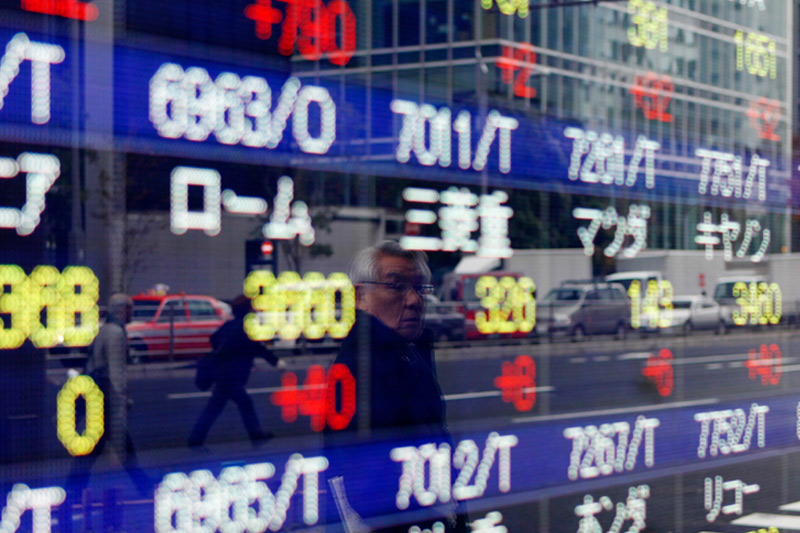Powell’s speech, Nvidia’s chips, Meta deal - what’s moving markets
* Asian stock markets: https://tmsnrt.rs/2zpUAr4
* Tracking the coronavirus: https://tmsnrt.rs/3aIRuz7
* Fed rate cut fails to calm nervous investors
* Equities extend global selloff
* Oil market faces falling demand, more Saudi supply
By Stanley White
TOKYO, March 17 (Reuters) - Asian shares fell on Tuesday in
a topsy-turvy session following one of Wall Street's biggest
one-day routs in history as headlines about the coronavirus
outbreak and its global economic impact whiplashed investor
sentiment.
Financial markets cratered on Monday with the S&P 500 .SPX
tumbling 12%, its biggest drop since "Black Monday" three
decades ago, as a series of emergency central bank rate cuts
globally only added to the recent sense of investor panic.
While some markets such as U.S. stock futures bounced in
Asian trade after the major plunge, there were no convincing
reasons for a sustained rally.
MSCI's broadest index of Asia-Pacific shares outside Japan
.MIAPJ0000PUS gave up early gains to trade 0.5% lower. Japan's
Nikkei stock index .N225 fell 0.06% and South Korea's KOSPI
.KS11 was off 2.16%. Australian shares .AXJO were up 2.73%
although this followed a plunge of almost 10% on Monday.
"The move in U.S. stock futures prompted some buying of
battered down sharers and lifted dollar/yen," said Junichi
Ishikawa, senior FX strategist at IG Securities in Tokyo.
"The focus is shifting to the fiscal response to the virus.
We're locked in a pattern where markets bounce and then resume
falling."
U.S. stock futures ESc1 rose by their daily limit in Asian
trading, also driven in part by hopes for big U.S. fiscal
spending. This lifted some Asian bourses into positive
territory, but the gains did not last.
Some $2.69 trillion in market value was wiped from the S&P
500 on Monday as it suffered its third-largest daily percentage
decline on record. Over the past 18 days, the benchmark index
has lost $8.28 trillion.
Gold, which is normally bought as a safe-haven, extended
declines on Tuesday as some investors chose to sell whatever
they could to keep their money in cash.
Oil futures rebounded in Asia, but downside risks remain due
to an expected slump in global energy demand and Saudi Arabia's
plans to increase crude output to expand its market share.
The U.S. Federal Reserve stunned investors with another
emergency rate cut on Sunday, prompting other central banks to
ease policy in the biggest coordinated response since the global
financial crisis more than a decade ago.
Investors, however, are worried that central banks may have
spent all their ammunition and that more draconian restrictions
on personal movement are necessary to contain the global
coronavirus outbreak.
Group of Seven finance ministers are likely to hold a call
on Tuesday night, which has fuelled speculation that a
coordinated fiscal response could be in the works.
Traders are looking ahead to data due later on Tuesday,
which is forecast to show German investor sentiment tumbled in
March.
The United States will also release retail sales and
industrial production for February, which is unlikely to reflect
the impact of the coronavirus.
Some investors say markets will not settle unless the U.S.
government announces a big fiscal spending package to match the
Fed's bold actions to slash rates and keep credit markets
functioning.
Others say liquidity in some financial markets is starting
to fall because there's such a high degree of uncertainty,
meaning even some traditional safe-havens may not be that safe.
Spot gold XAU= fell 1.12% to $1,497.60 per ounce. GOL/
In the currency market, the Swiss franc CHF=EBS , another
safe haven, weakened by 0.3% to 0.9369 per dollar as traders
pondered policymakers next moves.
The dollar rose 0.7% to at 106.67 yen JPY=EBS , recovering
slightly from a 2% decline from the previous session as the
Fed's rate rippled through financial markets.
U.S. crude CLc1 ticked up 3.87% to $29.81 a barrel. Brent
crude LCOc1 also rose 2.53% to $30.81 per barrel, but these
gains are likely to be temporary.
Saudi Aramco (SE:2222) reiterated on Monday plans to boost output to
record levels. Top global oil producers Saudi Arabia and Russia
started a price war after failing to agree on a plan to curb
supply.
The coming flood of supply from Saudi Arabia and other
producers could result in the largest surplus of crude in
history, said global information provider HIS Markit.
(Editing by Sam Holmes)
